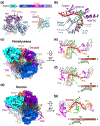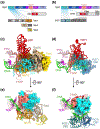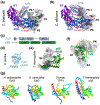Telomerase structural biology comes of age
- PMID: 36081246
- PMCID: PMC9884118
- DOI: 10.1016/j.sbi.2022.102446
Telomerase structural biology comes of age
Abstract
Telomerase is an RNA-protein complex comprising telomerase reverse transcriptase, a non-coding telomerase RNA, and proteins involved in biogenesis, assembly, localization, or recruitment. Telomerase synthesizes the telomeric DNA at the 3'-ends of linear chromosomes. During the past decade, structural studies have defined the architecture of Tetrahymena and human telomerase as well as protein and RNA domain structures, but high-resolution details of interactions remained largely elusive. In the past two years, several sub-4 Å cryo-electron microscopy structures of telomerase were published, including Tetrahymena telomerase at different steps of telomere repeat addition and human telomerase with telomere shelterin proteins that recruit telomerase to telomeres. These and other recent structural studies have expanded our understanding of telomerase assembly, mechanism, recruitment, and mutations leading to disease.
Copyright © 2022 Elsevier Ltd. All rights reserved.
Conflict of interest statement
Conflict of interest statement Nothing declared.
Figures




Similar articles
-
Structures of telomerase at several steps of telomere repeat synthesis.Nature. 2021 May;593(7859):454-459. doi: 10.1038/s41586-021-03529-9. Epub 2021 May 12. Nature. 2021. PMID: 33981033 Free PMC article.
-
Structural biology of telomerase and its interaction at telomeres.Curr Opin Struct Biol. 2017 Dec;47:77-87. doi: 10.1016/j.sbi.2017.06.010. Epub 2017 Jul 18. Curr Opin Struct Biol. 2017. PMID: 28732250 Free PMC article. Review.
-
Structure of Telomerase with Telomeric DNA.Cell. 2018 May 17;173(5):1179-1190.e13. doi: 10.1016/j.cell.2018.04.038. Cell. 2018. PMID: 29775593 Free PMC article.
-
Structure of active human telomerase with telomere shelterin protein TPP1.Nature. 2022 Apr;604(7906):578-583. doi: 10.1038/s41586-022-04582-8. Epub 2022 Apr 13. Nature. 2022. PMID: 35418675 Free PMC article.
-
Integrative structural biology of Tetrahymena telomerase - insights into catalytic mechanism and interaction at telomeres.FEBS J. 2016 Jun;283(11):2044-50. doi: 10.1111/febs.13691. Epub 2016 Mar 17. FEBS J. 2016. PMID: 26918633 Free PMC article. Review.
Cited by
-
Telomeres and telomerase in Sarcoma disease and therapy.Int J Med Sci. 2024 Aug 6;21(11):2065-2080. doi: 10.7150/ijms.97485. eCollection 2024. Int J Med Sci. 2024. PMID: 39239547 Free PMC article. Review.
-
Telomere C-Strand Fill-In Machinery: New Insights into the Human CST-DNA Polymerase Alpha-Primase Structures and Functions.Subcell Biochem. 2024;104:73-100. doi: 10.1007/978-3-031-58843-3_5. Subcell Biochem. 2024. PMID: 38963484 Review.
-
Models for human telomere C-strand fill-in by CST-Polα-primase.Trends Biochem Sci. 2023 Oct;48(10):860-872. doi: 10.1016/j.tibs.2023.07.008. Epub 2023 Aug 15. Trends Biochem Sci. 2023. PMID: 37586999 Free PMC article. Review.
-
Orchestrating nucleic acid-protein interactions at chromosome ends: telomerase mechanisms come into focus.Nat Struct Mol Biol. 2023 Jul;30(7):878-890. doi: 10.1038/s41594-023-01022-7. Epub 2023 Jul 3. Nat Struct Mol Biol. 2023. PMID: 37400652 Free PMC article. Review.
-
Telomerase RNA structural heterogeneity in living human cells detected by DMS-MaPseq.Nat Commun. 2025 Jan 22;16(1):925. doi: 10.1038/s41467-025-56149-6. Nat Commun. 2025. PMID: 39843442 Free PMC article.
References
Publication types
MeSH terms
Substances
Grants and funding
LinkOut - more resources
Full Text Sources
Miscellaneous

